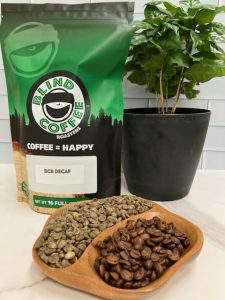We’ve been learning a lot about how to brew coffee to get all of the best flavors out of it. But how do you know what kind of flavors a coffee should have? Some of the flavor is determined by growing region and altitude; we’ll get into that later. Another factor in coffee’s flavor is the processing method.
Processing is what happens to the coffee fruit between being picked and being bagged up for sale. Processing determines how much of the coffee cherry gets left on the bean.
There are three major ways to process coffee: washed, natural, and honey. You’ve probably seen those words on our bags. There are some less common processing methods too that produce some really interesting flavors.
Washed
Washed process coffees are exactly what they sound like. Coffee producers wash the coffee fruit off of the beans, and then spread the clean beans on patios to dry. Washed process coffees have a clean flavor and mouth feel. They typically have more of the chocolatey and nutty flavor notes. Try out our washed process coffees here.
Natural
Natural process coffees leave the fruit on the coffee bean while it dries. This imparts some of the fruity taste from the cherry to the coffee bean itself. Once the bean dries, producers remove the coffee cherry. The natural process is great because it uses the least amount of water, and thus is more sustainable. It’s a great option for regions with low rainfall. Looking for those fruity flavors? Try our natural process coffees.
Honey
Honey process coffees are sort of like a hybrid of the washed and natural processes. Farmers leave some of the coffee fruit on the bean. Then the farmers wash the coffee bean with some water and the mucilage from the fruit (this is the ‘honey’ part).
There are 3 kinds of honey processes: yellow, red, and black. Yellow honeys are processed just as described, with a little bit of washing with the fruit’s mucilage. Red honeys are left to ferment for a short period of time before being washed and dried. Black honeys are fermented for longer and then washed and dried. Honey processed coffee tends to have a lot of sweetness and a hint of fruit. Shop honey process coffees here.
Anaerobic
Another, newer way to process coffee is the anaerobic method. Anaerobic can start with washed, natural, or honey processed coffee. After that initial process, coffee producers put the coffee beans into tanks with water, and then force out all the oxygen. The beans ferment for a few days without oxygen.
As fermentation builds pressure in the tank, it forces the sugars and fruit flavors into the bean. Next producers dry the beans. These coffees have a strong fruit or spice flavor with a wine-y quality to them. Anaerobic process coffee typically comes in small batches. We love to carry it when we can, but usually have them only for a limited time. You can find ours here if you’re lucky enough to catch it at the right time. Sometimes farmers add fruit to the anaerobic process for a Co-Ferment which also increases the fruity notes.
Wet Hulled
Wet hulled processing is rarely done outside Indonesia. That’s because Indonesia’s climate is so rainy and humid that other processing methods, which usually involve drying the beans on the farm, are not feasible. Instead, the farmers pick the cherries and run them through a de-pulper that removes the skin. Next they ferment the beans overnight to break down the fruit. Then they dry the coffee to just 50% moisture content before sending it to the coffee mill.
At the mill, they dry the coffee a little more and then send it through a wet huller to remove the parchment layer around the bean. Finally, they air dry the coffee to 12% moisture and it is ready to sell. Wet hull processing gives the beans their classic Indonesian funk and low acidity. Pick up our wet hulled beans here.
Decaf
Finally, there’s the decaffeination process. There’s a few different methods. Our decaf is a sugar cane decaffeination process. Here’s how the sugar cane decaffeination process works: The farmers soak the green coffee beans in water and ethyl acetate. That might sound like a scary chemical, but it’s actually a naturally occurring compound that comes from fermenting sugar cane. Then the ethyl acetate binds with the caffeine and pulls it out of the bean. The sugar cane process removes 97% of the caffeine, and it’s organic.
Using sugar cane gives the coffee more flavor and body than other kinds of decaffeination processes. And because producers do this process on the farm, it lowers the carbon footprint. You can find our decaf here.
We really think it’s remarkable all of the flavors that you can find in coffee. And we love trying them out and sharing them with you! Here’s to making great coffee at home!

